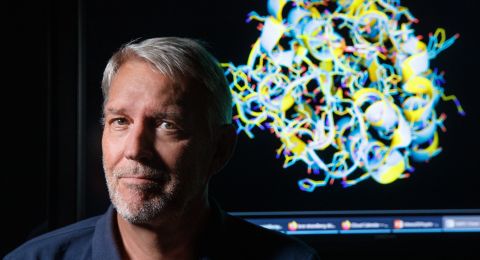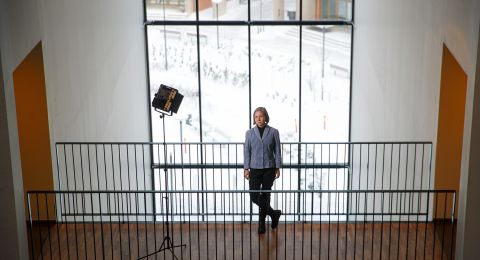All matter on Earth and in the universe is made up of elementary particles that have existed since just after the Big Bang. Wallenberg Scholar Sara Strandberg is studying how the particles interact with each other. She is using data from the LHC particle collider at CERN to learn more about the Higgs Boson and the part it plays in the Standard Model of particle physics.
Sara Strandberg
Professor of Elementary Particle Physics
Wallenberg Scholar
Institution:
Stockholm University
Research field:
Experimental elementary particle physics; the Higgs Boson and physics beyond the Standard Model.
“The reason I’m so interested in particle physics is that it’s about understanding the constituents of the universe and the laws that govern them at the most fundamental level. To make progress we need to continue making the kind of measurements my research team is involved in,” Strandberg says.
Her work is based on data from experiments using the Large Hadron Collider (LHC) at CERN in Switzerland, where she has spent a great deal of time over the years.
“I’m especially interested in the Higgs Boson. It plays a key role in the Standard Model (see fact box) of particle physics, which describes the forces acting on the elementary particles. The Higgs Boson gives other particles their mass. More knowledge about the Higgs Boson is essential for progress in research in particle physics.”
When the Higgs Boson was discovered at the LHC in 2012, it had been about 50 years since physicists François Englert and Peter W. Higgs had predicted its existence. Strandberg was one of thousands of researchers involved in a gigantic and successful team effort to produce experimental proof of the particle’s existence. Thanks to their discovery, Englert and Higgs shared the Nobel Prize in Physics in 2013. Since then Strandberg has continued to explore the Higgs Boson in various ways.
“One might think that the Higgs Boson is ‘old news’, but it’s not even ten years since we found it, and there’s still so much to learn about this particle. There is also a good chance of making discoveries that fall outside what is expected of the Standard Model.”
Flawed model
The research conducted by Strandberg and others at the LHC is based on the premise that the Standard Model as it is currently understood cannot be the final theory on the structure of the universe.
“The Standard Model has flaws that we have to address. One is that it does not include gravity. Another is that it cannot explain dark matter or why the universe consists of matter and anti-matter in equal parts. We are working to expand the Standard Model to obtain answers to these questions.”
The research team is carrying out the experiments using ATLAS, one of LHC’s particle detectors, and the largest of its kind in the world. It is located in a 27-kilometer-long tunnel a hundred meters below ground. In it, protons collide with each other at close to the speed of light. These high-energy collisions convert them into other particles.
“The particles created at the LHC are often very short-lived and are converted extremely quickly,” Strandberg explains.
The detector at the LHC churns out time-stamped data consisting of ones and zeros. The researchers then use tailored algorithms to trace the data back to specific particles, processes and properties. Parameters measured include energy and patterns of movement.
Strandberg has made many studies of a phenomenon known as supersymmetry. This is a potential expansion of the Standard Model whereby each elementary particle has a “supersymmetric” partner.
“One of the problems that supersymmetry can solve is why the mass of the Higgs Boson is not well predicted in the Standard Model. The model has to be fine-tuned a great deal to fit in with the mass measured by experiments. I’ve been looking for a supersymmetric particle capable of providing a natural explanation for the Higgs mass.”
“The best thing about receiving the Scholar grant is that it enables me to broaden my research and gives me the courage to try out new approaches. I can now take a closer look at ideas I’ve had at the back of my mind but haven’t had the resources to realize and pursue.”
Higgs Boson has high priority
The Higgs Boson is really a disruption or, in the language of physics, an “excitation” in the invisible Higgs field that permeates all of space. The other particles in the Standard Model acquire their mass via their interaction with the Higgs field.
As a Wallenberg Scholar, Strandberg wants to examine the Higgs Boson more closely.
“I have long wanted to broaden my research and take a closer look at precision measurements involving the Higgs Boson. A high-profile measurement of this kind is known as ‘pair production’ of Higgs Bosons, which may give us vital information on properties of the Higgs field – properties that are in turn central to understanding evolution of the universe.”
Strandberg mentions that measurements of the Higgs Boson also have high priority in the European particle physics community’s strategy for continuing work at the LHC. LHC has been closed for some years pending an upgrade. It is due to open again in 2022. But a further major upgrade to “High-Luminosity LHC” is planned for 2026, to allow more particle collisions and more details to be measured, such as pair production of Higgs Bosons.
“It will enable us to collect ten times as much data and to search for more processes. For the first time our experiments at the LCH are now in a phase where we need both to analyze existing and future data more efficiently, and to upgrade the technology to make further progress. It is a major challenge to balance these two key requirements.”
Text Susanne Rosén
Translation Maxwell Arding
Photo CERN, (c) 2015 ATLAS Collaboration CERN, Markus Marcetic, Sara Strandberg






